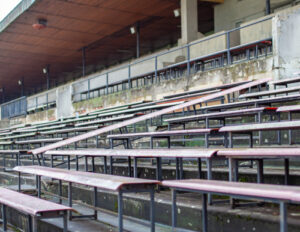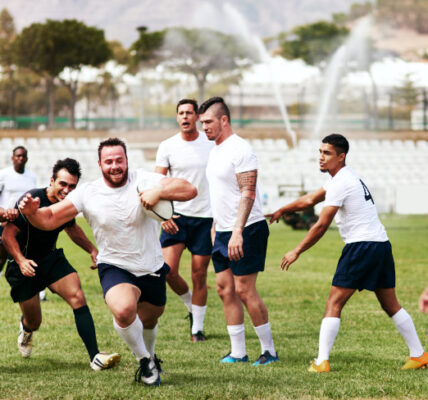There are stadiums in KwaZulu-Natal where the grass has long since taken back the field, where goalposts lean like tired giants, and the stands sit empty save for wind and birds. These aren’t the grand arenas you see on TV, Kings Park filled to the rafters, anthem echoing through a sea of green and gold. These are the quiet fields. The forgotten places. The ghost stadiums.
Drive through towns like Empangeni, Richmond, or even the outskirts of Pietermaritzburg and you’ll find them. School fields where provincial legends first ran drills now gated off or cracked under sun. Community grounds once roaring with Saturday leagues now echo with nothing but the scrape of wind against rusted bleachers. These silent stadiums tell their own story.
During the 1970s and 80s, before sponsorships turned professional rugby into a polished business, KwaZulu-Natal’s rugby culture was stitched together in places like Umlazi Township or deep in the Midlands. Every suburb, every school, every company seemed to have a side. Matches weren’t just sport, they were social fixtures. Bring-and-braai Saturdays.
Cash-only betting on the touchlines. Music crackling from old speakers. These stadiums were more than sporting grounds, they were social epicentres, places where local pride and personal history interwove. Then came the professional era. Television rights. Big sponsors. The flow of money shifted. Small stadiums that once held a few hundred loyal supporters fell quiet as attention turned to televised fixtures in bigger cities.
In Richmond, just off the main road, there’s a stadium that once hosted Natal Midlands trials. Now, its gates sag on broken hinges. The ticket booths are coated in graffiti. Locals still remember the name, Madlala Stadium. “That’s where we learned to love rugby,” says Thulani, a shopkeeper nearby. “It wasn’t just about winning. It was where people met. After church. After work.”
That feeling repeats across towns. Ghost stadiums as quiet reminders of how things shift. Rugby in KwaZulu-Natal is still alive, still woven into daily life, but it’s evolved. From grassroots community clubs into high-performance academies and big franchise matches. Yet for every modern player rising through the Sharks system, there are fields where they once watched from the sidelines as kids. And not all these fields are completely dead.
On some evenings, when the sun dips low and shadows stretch long, you’ll find kids hopping fences to play touch rugby on overgrown grass. No posts? No problem. They improvise. Tyres stacked as markers. Old crates for goal areas. It’s scrappy, but it’s rugby. Maybe even purer rugby in its own way. For these children, the crumbling concrete and weed-infested sidelines are part of the game, not a hindrance.
There’s something haunting in those moments. The ghosts of past games mixing with new energy. Forgotten stadiums serving one last purpose: space to play. It’s a patchwork kind of revival, unofficial, unsanctioned, but no less real. Rugby isn’t defined solely by grandstand lights or national anthems. Sometimes, it’s defined by the crack of bare feet on dry ground, the laughter carried by wind.
Of course, some stadiums are getting second lives. In 2023, an NGO project partnered with local councils to restore small rugby grounds in places like Ixopo and Howick. Not to host televised matches, but to create safe spaces for youth development programmes. Rugby as a vehicle for more than sport, teaching discipline, teamwork, resilience. These renovated grounds aren’t necessarily polished, they keep their original character, their old scars. But they’re functional again. And for communities, that makes all the difference.
That’s where the real power of these ghost stadiums lies. Not just in memory, but in potential. A once-forgotten field can become a launchpad for local talent, or simply a safe space where kids learn life lessons they won’t find in a classroom.
 At the edge of Greytown, there’s a ground called Mpofana Park. Officially, it’s listed as “disused.” But walk there on a Sunday and you might hear the thud of boots on earth. Unofficial leagues. Cash pools collected from spectators. No sponsors, no broadcast crews, just community. There are vendors selling homemade vetkoek, the smell of woodsmoke in the air, the occasional uncle with a plastic megaphone shouting advice from the sidelines.
At the edge of Greytown, there’s a ground called Mpofana Park. Officially, it’s listed as “disused.” But walk there on a Sunday and you might hear the thud of boots on earth. Unofficial leagues. Cash pools collected from spectators. No sponsors, no broadcast crews, just community. There are vendors selling homemade vetkoek, the smell of woodsmoke in the air, the occasional uncle with a plastic megaphone shouting advice from the sidelines.
What’s striking is how rugby continues to pulse through these places despite everything. Infrastructure crumbles, but the spirit remains. In some cases, it’s the only regular gathering point left. Shops may close, schools may merge, but the field, the field stays.
And maybe that’s the quiet thread tying all this together. Rugby in KZN isn’t just about the big lights and big names. It’s about what happens when the crowd goes quiet. When stadiums empty but hearts don’t. Because as long as there’s a ball, as long as there’s a patch of ground, rugby lives on.
Those ghost stadiums? They’re not dead, they’re waiting. Waiting for the next generation. Waiting for the next boot to strike the ball. Waiting for old hands to return with younger ones in tow, pointing to faded lines on the grass and saying, “That’s where I played.” And maybe that’s what makes them special. Not the grandeur. Not the history books. But the quiet resilience of place. The way grass grows back, cracks mend, and stories begin again. One whistle. One kick. One more match.
Where some see emptiness, others see potential. That’s rugby in KwaZulu-Natal: not just a game, but a living, breathing thread connecting past and future, even when no one is watching.




